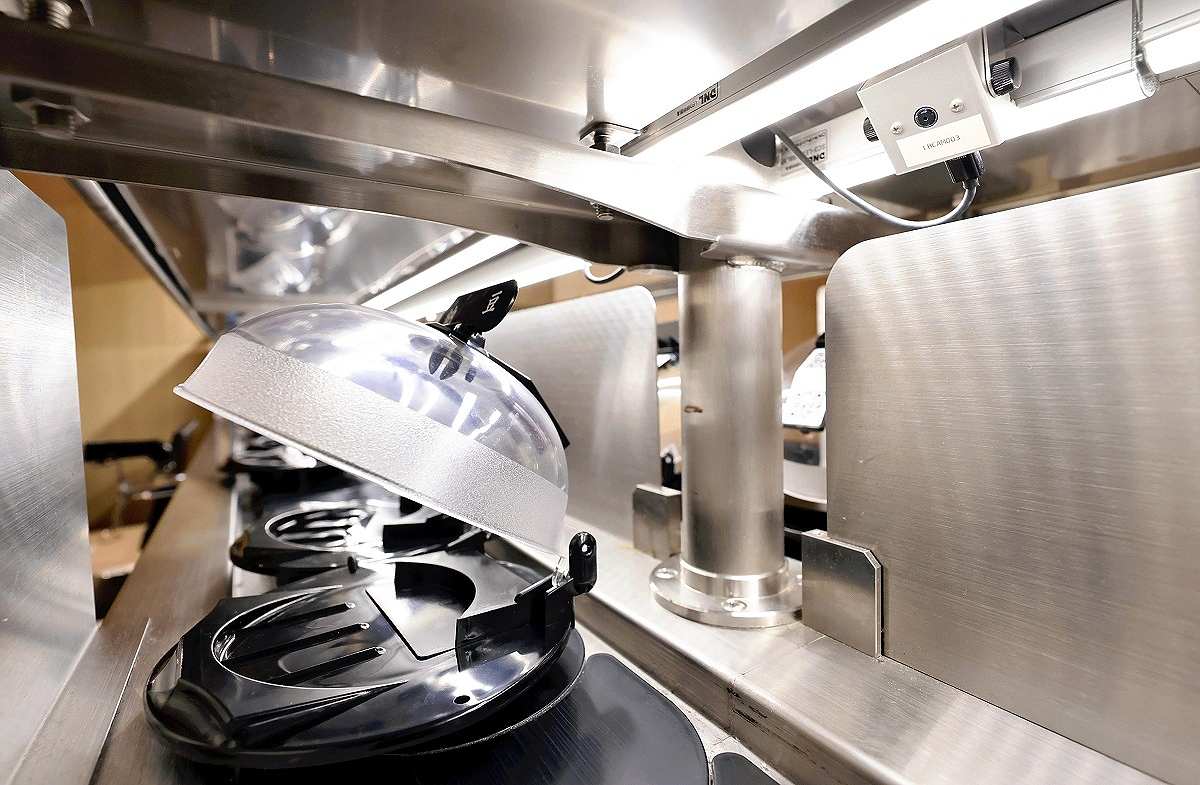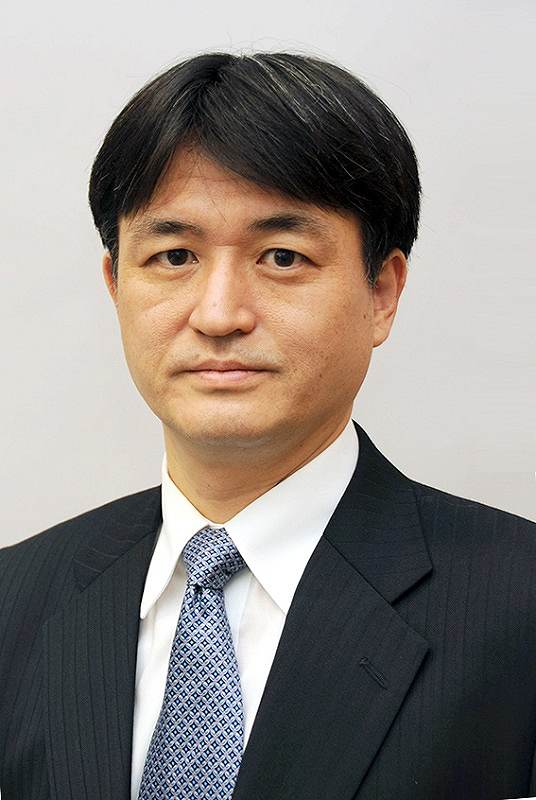
A tiny camera, top right, is part of an artificial intelligence surveillance system that Kura Sushi Inc. introduced. It monitors suspicious movements on the conveyor belts
8:00 JST, March 18, 2023
Japan’s kaitenzushi restaurant chains, which serve sushi via conveyor belts, are experiencing a tough time due to prank videos in which miscreants lick communal bottles of soy sauce, remove sushi plates from the conveyor belts and then put them back, and spray disinfectant on sushi. Such videos have been uploaded to Twitter and other social media sites, and affected companies are taking measures to minimize the impact on their customers. Some foreign TV news shows have even described it as “sushi terrorism.”
Kaitenzushi restaurants are popular among Japanese consumers as an entertaining way to eat sushi. They have many customers of every generation. Kaitenzushi is also popular among foreign visitors to Japan. It is a major Japanese invention that has been exported abroad.
The recent wave of “sushi terrorism” is a major blow to Japanese society in two ways. First, Japan’s proud culinary culture, including food and restaurant safety and security, is now at risk. Second, it has exposed a vulnerability of the kaitenzushi business model.
Hygiene and food safety are essential for the food service industry, but Japan’s long-standing tradition of mutual trust that no one would do anything untoward has been shattered.
In many of the latest series of deliberately outrageous videos — like the “part-timers’ terrorism” phenomenon that emerged several years ago, also involving prank videos — the perpetrators are believed to be young people who want to attract attention.
Prank videos have been around for a long time. But now, the difference is that the number of social media platforms has increased and information is disseminated much more quickly. Pranksters can even generate advertising revenue by spreading footage of their exploits via multiple social media platforms. Akindo Sushiro Co., one of the major kaitenzushi chains, was particularly hard-hit by the seemingly endless diffusion of such a video on social media.
However, the perpetrators themselves can pay a big price. The industry is taking a tough stance against this offensive behavior, adopting stern measures to deter it by both criminal and civil sanctions. By early March, three suspects were arrested by Aichi prefectural police on suspicion of forcible obstruction of business. One of them allegedly put his mouth on the spout of a soy sauce dispenser. They were accused of having interfered with the sushi restaurant’s business by forcing it to give the facility an additional cleaning and deal with complaints.
Kaitenzushi chains have been competing by keeping their prices low. They have devised new methods of purchasing fish, the raw material for sushi. In addition, as a measure to cope with the chronic labor shortage, they utilize information technology solutions to “smarten up” their operations. Customers order and pay by self-checkout. Through these cost-cutting measures, many restaurants were able to offer sushi dishes for less than ¥200 each. However, the lax state of customer monitoring systems, which had been left unattended amid such streamlining, has been exploited.
In response, the kaitenzushi industry has begun to take countermeasures. These days, restaurants have removed soy sauce and other condiments from the tables and have the staff bring in new ones each time a customer arrives. As a new measure, Kura Sushi Inc. introduced a surveillance camera system in early March that uses artificial intelligence to monitor suspicious movements on the conveyor belts in all of its outlets across Japan.
Hama-Sushi Co. is also considering introducing surveillance cameras and sensors in its restaurants. Sushiro has implemented a temporary measure to serve only food items specifically ordered by customers on its conveyor belts. These measures are a heavy blow to the industry as it has been under pressure for years to cut costs. The kaitenzushi business has boosted consumers’ appetite for many years. But it may reach a turning point as a result of these despicable crimes.
Political Pulse appears every Saturday.

Hiroyuki Nakamura
Nakamura is the editor of the Economic News Department of The Yomiuri Shimbun Osaka.
"Editorial & Columns" POPULAR ARTICLE
-

Violations of Subcontract Law: Major Automakers Must Eliminate Old Practices
-

Local Governments’ Tax Revenues: Devise Ways to Correct Imbalances in Tax Sources
-

5 Japanese Business Dinner Mistakes to Avoid — and What They Taught Me About Business in Japan
-

Heavy Rains in Asia: Support for Victims, Flood-Control Measures Urgently Needed
-

Rice Coupons: A Misguided Approach to Countering Rising Prices
JN ACCESS RANKING
-

Tokyo Economic Security Forum to Hold Inaugural Meeting Amid Tense Global Environment
-

Keidanren Chairman Yoshinobu Tsutsui Visits Kashiwazaki-Kariwa Nuclear Power Plant; Inspects New Emergency Safety System
-

Imports of Rare Earths from China Facing Delays, May Be Caused by Deterioration of Japan-China Relations
-

University of Tokyo Professor Discusses Japanese Economic Security in Interview Ahead of Forum
-

Japan Pulls out of Vietnam Nuclear Project, Complicating Hanoi’s Power Plans























